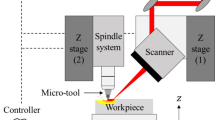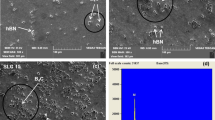Abstract
An improved method for cutting thick polycrystalline cubic boron nitride (PCBN) tool blanks is explored because current methods of pulsed Nd:YAG laser cutting and wire electrical discharge machining (EDM) are constrained by low speed and low precision. We present a CO2 laser/waterjet (LWJ) process to cut 4.8-mm-thick PCBN tool inserts by a crack separation mechanism. In LWJ, the PCBN blank is locally heated using a high-power continuous wave CO2 laser to cause phase transition from cubic to hexagonal followed by water quenching to generate thermal stresses and form boron oxide leading to increased brittleness, subsequent cracking, and material separation. A 23 fractional design of experiment (DOE) approach was employed to determine the factors of laser power, cutting speed, and waterjet pressure on the responses of phase transformation depth, taper, and surface roughness. A numerical heat flow model, based on Green’s function, was used to calculate the temperature distributions along the depth. Surface profilometer, scanning electron microscopy, and Raman spectroscopy were utilized to analyze the phase transformation and crack zones. Results from LWJ compared with pulsed Nd:YAG laser and laser microjet™ methods indicate LWJ cuts 30 times faster; this was attributed to a nonconventional material removal (crack separation) mechanism. When LWJ was compared against nitrogen-assisted CO2 laser cutting, improved cut quality (less taper and smaller heat-affected zone) was observed due to a greater control on phase transformation and crack propagation. DOE analysis revealed laser power and waterjet pressure, and the interactions among them are more significant factors than others.
Similar content being viewed by others
References
Wentorf RH (1957) Cubic form of boron nitride. J Chem Phys 26(4):956
Ding X, Liew WYH, Liu XD (2005) Evaluation of machining performance of MMC with PCBN and PCD tools. Wear 259(7–12):1225–1234
http://www.ssl-laser.com . Accessed on 21 April 2013
http://www.iskydiamond.com/product/01.php?cb_idx=9 . Accessed on 21 April 2013
Pauchard, A. High power applications of the laser microjet. http://www.swissphotonics.net/libraries.files/SwissLaserNet_11.09.pdf . Accessed on 21 April 2013
Pauchard A, Marco MD, Carron B et al (2008) Recent developments in the cutting of ultra hard materials using water jet-guided laser technology. ALAC Conference, Minneapolis
Kalyana-sundaram D, Wille J, Shrotriya P, Molian P (2008) Laser/waterjet machining of polycrystalline cubic boron nitride. Trans NAMRI/SME 131:517–524
Melaibari A, Shotriya P and Molian P (2011) Effect of fluid medium on laser machining of polycrystalline cubic boron nitride tool. 44th CIRP Conference on Manufacturing Systems, May 31–June 3, Madison, WI
Melaibari A, Molian P, Shrotriya P (2012) Two–dimensional contour cutting of polycrystalline cubic boron nitride using a novel laser/water jet hybrid process. Int J Adv Manuf Technol 62:641–649
Wang J, Gu Y, Li Z et al (2013) Growth and optical properties of explosion phase boron nitride octahedron crystals. Am Chem Soc 13(2):599–605
Leichtfried G et al (2002) Properties of diamond and cubic boron nitride. In: Beiss P, Landolt Börnstein—Group VIII (eds) Advanced materials and technologies: powder metallurgy data. Refractory, Hard and Intermetallic Materials. Springer, Berlin, pp 118–139
Liu QX, Yang GW, Zhang JX (2003) Phase transition between cubic-BN and hexagonal BN upon pulsed laser induced liquid–solid interfacial reaction. Chem Phys Lett 373(1–2):56–61
Barin I (1996) Thermochemical data of pure substances, 3rd edn. VCH, New York, pp 104–121
Dreger LH, Dadape VV, Margrave JL (1962) Sublimation and decomposition studies on boron nitride and aluminum nitride. J Phys Chem 66(8):1556–1559
Gielisse PJ, Mitra SS, Plendl JN et al (1967) Lattice infrared spectra of boron nitride and boron monphosphide. Phys Rev 155(3):1039–1046
Akasaki I, Hashimoto M (1967) Infrared lattice vibration of vapour-grown AlN. Sol State Commun 5(11):851–853
Sachdev H, Haubner H, Noth H, Lux B (1997) Investigation of the c-BN/h-BN phase transformation at normal pressure. Diam Relat Mater 6(2–4):28
Author information
Authors and Affiliations
Corresponding author
Rights and permissions
About this article
Cite this article
Wang, Y., Molian, P. & Shrotriya, P. Crack separation mechanism in CO2 laser machining of thick polycrystalline cubic boron nitride tool blanks. Int J Adv Manuf Technol 70, 1009–1022 (2014). https://doi.org/10.1007/s00170-013-5312-3
Received:
Accepted:
Published:
Issue Date:
DOI: https://doi.org/10.1007/s00170-013-5312-3




